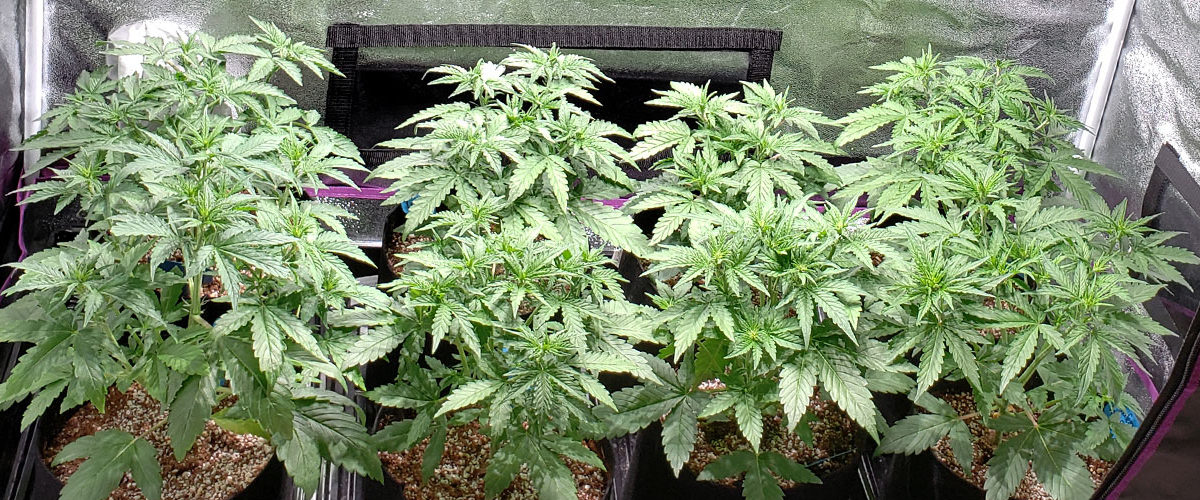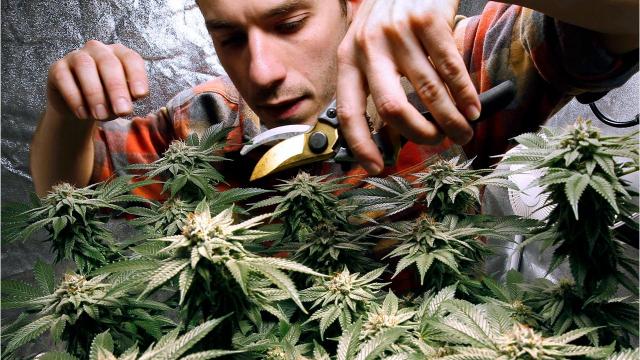Growing cannabis is a fun and rewarding experience, but it is also challenging and takes a certain amount of time and money. For a first-time grower with limited resources, an indoor grow is probably too costly of an option.
The good news is that a small outdoor garden can yield plenty of quality cannabis without a large monetary investment. If you have access to a sunny spot in a private yard or even a balcony, terrace, or rooftop, you can successfully grow cannabis.
Benefits of growing weed outdoors

- Low costs: Relying on the power of the sun, you won’t need to spend a ton of money on an outdoor grow. You’ll need some soil, fertilizer, seeds or clones, and maybe a small greenhouse to get them started. You won’t need to pay for electricity for lights, AC units, or dehumidifiers, and you can even collect rainwater.
- Big yields: The sky’s the limit with outdoor plants—you can let them get as big and tall as you want, as long as they’re manageable. One plant can potentially yield up to a pound of weed! Growing a handful for yourself is plenty. With an indoor grow, your space is a lot more restricted.
- Environmentally friendly: Indoor grows can be wasteful, using a ton of electricity to power all those lights, fans, and other equipment. The sun and the wind are free!
- It’s fun and relaxing: Don’t underestimate the therapeutic value of gardening. It’s relaxing to spend some time outside, roll up your sleeves, and get your hands dirty for a while. And there’s nothing better than smoking something you grew yourself.
How to start growing weed
To set up an indoor garden, you will need equipment to help create a stable environment that mimics the necessary periods of light and darkness to grow plants through the flowering stage. This includes horticultural lighting, fans to recreate a gentle breeze, dehumidifiers to maintain the proper humidity, HVAC (heating, ventilation, and air conditioning), and all the basic supplies that a plant needs to survive, from water to grow media to nutrients.
Planning, designing, and implementing an indoor garden can seem daunting, but having a firm understanding of the basics goes a long way in helping a new indoor grower get started on the path to a healthy and bountiful harvest.
What Is the best way to grow marijuana indoors?
The first step in creating a proper indoor growing environment is to decide on the medium and irrigation methods you’ll be using to supply your plants with the proper nutrients throughout their growth cycle. The medium is a shelter for your plants’ roots that retains moisture. The irrigation method is the way you deliver nutrients to the plants.
Unlike outdoor cultivation — where you almost always use soil to grow your plants — growing indoors offers several different options for growing systems and media. Some media are easier to work with than others, while some are a little trickier, but offer more control over the finer details. Different media retain moisture at different rates, which in turn determines how often plants need to be watered. Some media harbor beneficial microbes that can help roots absorb nutrients better.
The two main options for an indoor garden are soil and hydroponic media. Consider the following:
Soil
Soil is a great choice for beginners. It can be much more forgiving and requires less precision when watering and feeding plants. Less-frequent watering and a stable pH foundation can drastically increase the likelihood of a successful first harvest. Soil also contains beneficial microbes and nutrients that help keep plants healthy, though it also creates favorable conditions for pests, mold, and mildew to spread. Working with soil and hand-watering plants can also be messy, but it will allow you to get familiar with the pace in which your plants consume water and nutrients.
Hydroponics
Hydroponic media are viable indoor alternatives to soil, but they’re considered more advanced because they bring with them a set of challenges that may prove difficult for beginners. Then again, if going hydroponic is in your plans, it’s best to learn the method from the beginning.
Hydroponics is a blanket term for the growing of plants in a nutrient solution, with or without an inert medium to provide physical root support. Media such as fused basalt rock and chalk (known as rockwool), coconut fiber (coco coir), and clay pellets (hydroton) can drastically improve nutrient delivery. With a plant’s roots system exposed, hydroponically grown cannabis can grow faster and more efficiently, requiring less water and fewer nutrients but also requiring monitoring systems to ensure a stable pH.
Soilless mediums

Rockwool, also known as mineral wool, is one of the most common forms of hydroponic media for the beginning stage of a plant’s life. Rockwool is an inert substance, and its composition of mineral or rock fibers provides a relatively sterile environment with a unique capacity to hold water. Rockwool will quickly expose any watering or feeding mistakes. Missing even one day of watering could be detrimental when using rockwool, especially for tender young plants.
Coco Coir is the fibrous material found on and in coconut shells. As a byproduct of the coconut industry, it is favored by growers as a sustainable and renewable medium. Coco coir is an inert medium with a neutral pH that does not provide or maintain any nutrients. These qualities are great for growers who know how to appropriately adjust pH, allowing for quick pH and nutrient changes. There may be a learning curve, but if you’re numerically inclined, it’s not too hard to get a grip on the process. Coco coir can be used either by itself or added to soil or hydroton for improved drainage and growth capability.
Hydroton is a lightweight expanded clay aggregate composed of porous clay pebbles that can be used alone in a hydroponic system or blended with soil or other soilless mediums. Hydroton does not retain water to the extent of coco coir or rockwool, but it does provide plant roots with equal levels of oxygen. Like rockwool, the biggest issue is that it can dry out very quickly, so you have to be extra careful to keep it hydrated, especially when used on its own.
Other common soilless mediums used by hydroponic growers include perlite, vermiculite, coarse sand, and gravel. Advanced growers frequently mix these media in custom quantities to create blends that suit their specific growing style and environment.
Cannabis feeding systems
Feeding your plant is the process of giving it the chemicals and compounds that it needs to grow out its leaves, roots, and ultimately produce the heavy, trichome-covered flower clusters called colas. There are two main types of feeding systems: drain-to-waste and recirculating.
A drain-to-waste system applies fresh nutrient solutions to the grow medium every time the plant is fed. Any nutrients that drain through the medium are then disposed of and not reused.
A recirculating system collects the nutrients and water that are used, replenishes them, but with a smaller amount of fresh nutrients, then reapplies the solution to the plants the next time the plant is fed. A grower will check the solution’s pH before and after adjusting the nutrients.
When using soil as your primary medium, drain-to-waste is the only possibility. In soilless hydroponic systems, it is up to the growers’ preferences. Most hydroponic growers will opt to maintain a drain-to-waste system, because it affords them full control over the application of nutrients. Recirculating systems are typically reserved for the most advanced and efficient cultivators.
Top feed drain-to-waste systems can be as simple as putting your plants in a soilless medium and watering them from the top of the container, either with a drip system or by hand.
Ebb and flow systems, also known as flood and drain systems, are a popular type of recirculating system that uses a pump to bring water and nutrients from a reservoir into a flood tray where the plants are positioned in their grow medium. The nutrient solution floods the tray and gets absorbed by the roots and medium before slowly draining back into the reservoir. This process repeats itself on a timer to ensure that plants are properly hydrated.
Nutrient Film Technique (NFT) is another recirculating system in which plants are suspended by net baskets or neoprene collars that run along a trough. A thin film of water and nutrients continually circulates through the bottom of the trough, providing food to the tips of the roots, while leaving a majority of the root mass exposed to air.
Deep Water Culture (DWC) is a modular bucket system that suspends the plant’s main stem in a net basket while the roots are completely immersed in a highly oxygenated nutrient solution. An air pump supplies the oxygen to the nutrient solution which circulates through 3-5 gallon, or 11.4-18.9 liter, pots. DWC buckets can be configured to run in a stand-alone drain-to-waste system, or all of the buckets can be connected together to run in a recirculating manner.
Aeroponics are hydroponic systems in which the roots are suspended in air and lightly misted with a nutrient solution on regularly timed intervals. This method can achieve faster growth rates while using less water and nutrients than other hydroponic systems, though this is considered of the most advanced methods of growing hydroponically.
